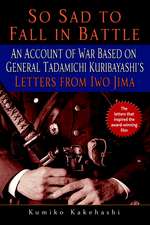Warrior Soul
Autor Chuck Pfarrer Spus de Chuck Pfarreren Limba Engleză CD-Audio
"Since the first navy frogmen crawled onto the beaches of Normandy, no SEAL has ever surrendered," writes Chuck Pfarrer. "No SEAL has ever been captured, and not one teammate or body has ever been left in the field. This legacy of valor is unmatched in modern warfare."
"Warrior Soul" is a book about the warrior spirit, and it takes the listener all over the world. Former Navy SEAL Chuck Pfarrer recounts some of his most dangerous assignments: On a clandestine reconnaissance mission on the Mosquito Coast, his recon team plays a deadly game of cat and mouse with a Nicaraguan patrol boat. Cut off on the streets of Beirut, the author s SEAL detachment must battle snipers on the Green Line. In the mid-Atlantic, Pfarrer s unit attempts to retrieve or destroy the booster section of a Trident ballistic missile before it can be recovered by a Russian spy trawler. On a runway in Sicily, his assault element surrounds an Egyptian airliner carrying the Achille Lauro hijackers.
These are only a few of the riveting stories of combat patrol, reconnaissance missions, counter-terrorist operations, tragedies, and victories in "Warrior Soul" that illustrate the SEAL maxim "The person who will not be defeated cannot be defeated.""
Preț: 57.08 lei
Nou
10.93€ • 11.87$ • 9.18£
Indisponibil temporar
Specificații
Notă biografică
From the Hardcover edition.
Extras
GOODBYE TO ALL THAT
It was a Friday night, and Gate 14 at Norfolk International was not crowded. American Airlines Flight 405 was a scheduled hop from Norfolk, Virginia, to Miami, with continuing service to San Juan, Puerto Rico. The maybe two dozen people in the departure lounge were hardly sufficient to fill even a third of the seats of the 727 now completing fueling at the end of the jet way. The bulk of American 405's passengers were said to be boarding in Miami for a weekend junket to the casinos and nightlife of San Juan.
When my row was called, I lifted my carry-on, showed my boarding pass, and walked down the jet way. Through the windows, I could see thunderclouds pressing low on the horizon. It was 8:25 p.m., only ten minutes before our scheduled departure, and the last red light of day was showing in the west. As the flight attendants closed the doors and made ready for departure, I found my seat and managed to push my duffel into the overhead rack. I had definitely exceeded the recommended dimensions for carry-on luggage. Concealed in my bag was an MT-1-X military parachute.
I wasn't going to Miami.
Like a dozen of my fellow passengers, I was going to jump from the airplane.
A closer look at the people in the departure lounge might have been instructive. Most of the passengers were under thirty-five, and the men all hard-eyed and fit. Some might have noticed that the passengers had a predilection for Rolex watches and expensive running shoes. Beyond that, they hardly seemed remarkable. The passengers were no mixed bag of civilians; they included a twelve-man Navy SEAL assault team. The balance of the people on American 405 included members of the Defense Intelligence Agency, air force combat controllers, navy parachute riggers, and a handful of officers from the Special Operations Command, based in Tampa, Florida. All were in civilian clothes; all exhibited what the military calls "relaxed grooming standards." In short, they blended in.
I was as unassuming as my fellow passengers. My reddish hair was collar-length, and my face was swathed by a luxuriant Wyatt Earp mustache, something I'd grown to add some authority to my perennially freckled face. My father used to tell me that I looked like a shaggy tennis pro, or some kind of overmuscled yachtsman. I certainly didn't look like what I was-an active-duty lieutenant in the United States Navy. Not just any lieutenant. As far as I was concerned, next to being a space-shuttle pilot, I had the best job in God's navy. I was an assault element commander at the navy's premier counterterrorist unit, SEAL Team Six. The other men hefting duffel bags were my shooters, my "boat crew," as the parlance went. I was in charge of tonight's festivities, a low-profile exfiltration and insertion exercise.
Two hours before flight time, we packed gear and weapons in the SEAL Team Six compound and individually proceeded to the airport. We checked unmarked suitcases containing our weapons and assault gear, and were issued tickets on a flight that was never intended to reach its scheduled destination. With the complicity of the airline, we were conducting a practice run for a covert mission.
There are a hundred ways that SEALs can insert into a target area. We can scuba dive from a submerged nuclear submarine. Boats can be dropped from airplanes in an event we call a "rubber duck." We can patrol across glacier, jungle, or desert. We can parachute or fast-rope from helicopters. Jumping out of commercial airliners is an operation, or op, we call a "D. B. Cooper." Using scheduled air traffic to insert into a hostile country, or a denied area, is a SEAL specialty.
Most people do not parachute on purpose from jet aircraft. The planes are too fast, and the turbulent air dragging in their wake can snap your spine and pop your hips from your pelvis. We were trained to jump from commercial airliners because they are ubiquitous and nonattributable. It is one thing to prohibit American military aircraft from flying over your country. It is quite another to close down your airspace to all commercial traffic. Libya, Syria, Cuba, and a host of other thug nations allow commercial flights to fly through their airspace. This is all the opening a SEAL Team needs. Unknown and unseen, a SEAL element can parachute into any place on earth. One might insert: that is, provided one survives the jump. The trick is to exit in correct body position and deploy your parachute after the appropriate delay. There are two principal types of SEAL parachute operations: HALO, or high altitude, low opening; and HAHO, high altitude, high opening.
In a HALO drop, you exit the aircraft at 35,000 feet on oxygen and open your parachute low, at 2,000 feet, to avoid detection. A jumper falling at terminal velocity, roughly 120 miles an hour, would scream in for a full three minutes before opening his parachute.
In a HAHO drop, jumpers exit the aircraft above 35,000 feet, but their parachutes are deployed after a brief delay, maybe three seconds, opening high instead of low-sometimes literally in the jet stream. The team floats under canopy at 33,000 feet, then groups together and glides in formation toward the target.
At six and a half miles up, the MT-1-X parachute has a thirty-knot forward airspeed, and you can cover a lot of miles before you ever see any dirt. Depending on the winds aloft, a jumper can touch down twenty or thirty miles from where he exited the aircraft. It's a good way to drop into a place where you are neither expected nor welcome.
We had all done both types of parachute missions, hundreds of them, and tonight's jump was supposed to be routine. This was a practice mission. In fact, it would be my last operational act as a Navy SEAL. I settled into my row, nodding hello to a woman seated across the aisle. I had been introduced to her at a briefing earlier. She said she was a State Department employee: the usual handle, we both knew, for a CIA officer. Like the brass from the Special Operations Command, she was aboard to observe our jump.
The plane was pushed back from the ramp, and the flight attendants pantomimed their safety briefings. Not surprisingly, nobody paid attention. American 405 was directed onto the active runway and cleared for takeoff. On the flight deck, in addition to an American Airlines captain, was a Navy SEAL, one of our operators rated as captain and pilot in command of more than a dozen types of commercial aircraft, everything from puddle jumpers to 747s and wide-bodied DC-10s. The SEAL pilot would fly the mission's insert and jump legs.
American 405 started her roll. As the plane climbed into the night, the pilot was advised by Norfolk ground to contact departure control on frequency 234.32. Switching to this frequency, the pilot now used the call sign Assailant 26, that of a navy aircraft. American Flight 405 had ceased to exist.
The blip on the radar screens of departure control did not turn south for the Blue Hair State, but headed north and east over the Virginia capes. Using the navy call sign, the pilot requested and was granted a direct route to SEAL DZ, a block of restricted airspace twenty-five miles off Virginia Beach.
As I looked out the window, Assailant 26 banked over the Cape Henry light tower. The plane shook as we flew into thickening rain clouds. I unbuckled my seat belt, stood, and turned to my leading petty officer, Alex Remero, a short, muscular Costa Rican, a demolition expert and decorated veteran of Grenada.
"Time to get dressed," I said.
My assault element was composed of three Cuban-Americans, a Costa Rican, a dreadlocked Puerto Rican, and a couple of white surfer dudes like me. We were famous for blaring reggae music in the Team room, and other assault elements called us the Rastamen. It was a moniker we were proud of. The Rastas had served together for three years, in all parts of the globe, in all elements-earth, wind, ocean, and fire-and we were a band of brothers.
As Assailant 26 rotated over SEAL DZ, we pulled our parachutes from the overhead racks. A hatch was opened on the deck of the rear galley, and Phil Fenko dropped into the luggage compartment. Like Alex, Phil was not a large man, but he was powerfully built; he had what we called a high thrust-to-weight ratio. You can forget the movies-most SEALs are not large men. I am six-three and weigh 220 pounds, considered large and slow for a Team guy. Most SEALs are around five-ten and 160 pounds. Not bodybuilders but triathletes. As Phil handed our suitcases up through the galley hatch, the parachute riggers went to work. They hooked carabiners to the deck track securing the seats and laid cables, pulleys, and come-alongs down the aisle of the aircraft to assist in opening and closing the tail ramp when jump time came.
Military parachuting differs from civilian jumping in two ways. First, in military parachuting, an adoring girlfriend isn't waiting for you on the drop zone-the enemy is. Second, we haul cargo. If there is a piece of equipment you think you might want on the ground, you jump with it. Although tonight's op was a training mission, we were jumping with full combat loads: weapons, ammunition, body armor, and assault gear, sixty-five pounds per jumper. During a "full mission profile," or real-world operation, it would not be unusual for a SEAL jumper to leave the airplane with 100 or even 150 pounds of gear. Satellite radios, night-vision equipment, antitank rockets, breaching demolitions, and diving gear are a few such pieces of "optional" equipment. Tonight we wore and carried only our shooting gear. This drop was considered a "Hollywood jump," the stuff of sissies.
We donned our baggy, light-gray jumpsuits. Over them we strapped on inflatable UDT life jackets, pistol belts, and low-draw holsters. This gear was considered our safety equipment. It included a .40-caliber Glock model 17 pistol, four magazines, a K-bar knife, a Mark-13 flare, and an infrared strobe light. Heckler & Koch MP-5 machine pistols were strapped to our thighs. This first line of gear would be our last line of defense-if it came down to life jackets, pistols, and smoke flares, we would be in a world of hurt.
The second line, our assault gear, was loaded into backpacks and cinched down tight. It consisted of Zainer waterproof body armor, a first-aid kit, a CamelBak water canteen, an encrypted radio, a Madonna-style headset, a ballistic helmet, an assault vest, and sixteen magazines for our MP-5s. Even on this practice mission, each man carried 480 rounds of .40-caliber Teflon-coated hollowpoint ammunition. These rounds were specially designed to pass through all known types of body armor, including our own.
Why carry live ammunition on a peacetime jump? In the SEALs, we train like we fight. It is essential that each jumper practices with the same equipment he would use on a combat jump. Learning how to exit the airplane, deploy your parachute, and land your rig with a combat load is not something you want to practice over downtown Baghdad.
We strapped on our parachutes, then connected the heavy backpacks to D rings on the front of each harness. All of our gear was secured with quick-release fittings. Within seconds of landing, we would be fully equipped and ready to rock.
As the riggers laid their cables, the air force combat controllers established radio communications with Landing Zone Green, a soccer field in Virginia Beach that would be our jump target. On LZ Green were parked three unmarked Chevy Suburbans from the Team. The drop zone crew was our reception committee, playing the role of friendly agents who would meet us as we touched down. In a real-world op, they would drive us to the target area or a safe house. Tonight all they had to do was hang out, make radio communications with the airplane, and wait for us to float to earth. Our exercise would end when my twelve-man assault element got to the ground.
As we completed equipment checks, one of the air force combat controllers came up to me. He didn't look happy. "The DZ reports winds northeast, twenty knots and gusting to thirty. Visibility is less than half a mile in heavy rain. Do you want to abort?"
"No," I said, "we can handle it."
As I said those words, lightning lit the sky around us, and the plane buffeted sharply. The air force guy grabbed a seat back to steady himself. He smirked. "Very studly."
The conditions were marginal, actually outside of parameters, but the parameters were guidelines. We had all jumped in worse. Besides, if we got this over with, we could make it to the Raven and grab a few beers before closing time. This would be my last op, and I was buying when we got to the bar. Although I wasn't looking forward to the tab, I was anxious to get on the ground before the weather got worse.
Nearly twenty months before, I had submitted a letter to the secretary of the navy, asking to resign my commission and leave the Teams. It had taken the navy almost two years to answer my request. When you hold a commission in the armed forces, you serve at the pleasure of the president. It had apparently not pleased the White House to let me go any sooner. The navy took its time in processing my letter, and I had been operational every day since putting in my papers. That was fine with me; there was nothing else I wanted to do in the navy. I just wanted out-eventually. Three days before, I'd gotten an answer to my request. My commission was to expire in three hours, at midnight.
So what was I doing standing in the back of a 727, waiting to jump into a soccer field in the middle of a Virginia suburb? As the plane shook and banked, I began to ask myself the same thing. As weird as it might sound, I was making the jump because I didn't want to.
I hated to jump. Unfortunately for me, my aversion to gravity was well known. I was teased for it, but I still made every jump, more than three hundred of them, three of them combat insertions, and I had to be a competent operator in the air. When you are trying to group twelve parachutes together in a stack at thirty-three thousand feet on night-vision goggles, there is no room for substandard performance. Besides, as they say in SEAL basic training, I didn't have to like it, I just had to do it. I was the boat-crew leader, and my boat crew drew this operation. If the Rastas were going to jump, then I would, too.
I turned to the combat controller and said, "Go for depressurization."
From the Hardcover edition.
Recenzii
—Kirkus Reviews (starred review)
From the Hardcover edition.
Descriere
A former Navy SEAL assault commander recounts some of his most dangerous assignments as he looks back on his time in the special forces.













